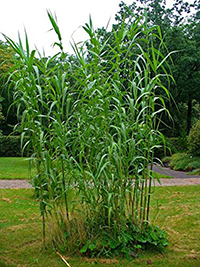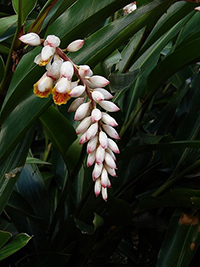Table of Contents
Dioscorides, the great Greek botanist and physician of the 1st century A.D., recommended giant reed to increase urine production. This plant was probably used in ancient times with these aims because it grows near streams.

Giant Reed Scientific Facts
- Other names: Cane, Spanish reed.
- Scientific name: Arundo donax L.
- French: Canne de Provence.
- Spanish: Cana comun.
- Environment: It is common along river banks and near streams all over the Mediterranean regions of Europe and spread all over America.
- Description: The plant of the Gramineae family grows up to 5 m high. It should not be mistaken for bamboo since only one leaf grows on every stem knot of a giant reed.
- Parts of the plant used medicinally: The rhizome (underground stem) and the root.
Healing Properties and Uses

The rhizome (underground stem) and the root of the giant reed contain sugar (saccharose) and many silicon derivatives. It has two main properties:
- Diuretic. It produces a mild increase in urine production, promoting the elimination of uric acid and other waste substances. It is recommended for people suffering from kidney colic and those who want to take a depurative treatment.
- Galactofuge. When taken for some days, giant reed stops milk production in breastfeeding women. It is helpful for all those women who, for any reason, want to give up breastfeeding.
How to use Giant Reed
- Decoction with the plant’s rhizome or root, sliced or ground, in a proportion of 50 grams per liter of water. Boil for 15 minutes, and drink two to four cups daily.
Spiked Alpinia

Spiked Alpinia grows in Central and South America. This plant is not a variety of giant reed since it belongs to another botanical family: Zingiberaceae. It grows one meter high and has large, slightly oval-shaped leaves 10 to 30 cm long. A white, yellow, or orange flower grows among the upper leaves. Due to its properties, this plant has been traditionally used in Latin American popular medicine.
- Diuretic. In addition to increasing urine production and eliminating waste substances, it has interesting anti-inflammatory properties on urinary organs. It is recommended for nephritis, kidney stones, and bladder inflammation or cystitis.
- Emmenagogue. It increases menstruation when this is not normal and calms menstrual pains (dysmenorrhea).
It is also used in decoction, prepared with mashed stems, roots, and leaves (50 grams of plant per liter of water). Boil for 15 minutes, and drink two to four cups daily. Sweeten with honey.
Frequently Asked Question
Can Giant Reed support my immune system?
Preliminary research suggests that compounds within the plant may have immune-boosting properties. These include polysaccharides that appear to stimulate the activity of specific immune cells.
Does Giant Reed have anti-inflammatory effects?
Traditionally, it has been used for its potential anti-inflammatory properties. Some early research supports this, indicating compounds in the plant may lessen inflammation pathways. Further research is needed to determine if this translates to benefits for specific human inflammatory conditions.
Could Giant Reed help in blood sugar management?
Animal studies suggest that leaf extracts might aid blood sugar control. More investigation is needed to see if those benefits extend to humans and to understand the mechanisms behind this potential effect.
Can Giant Reed benefit respiratory health?
Some limited research indicates it may have expectorant (loosens mucus) and antitussive (reduces cough) properties. The potential benefits for conditions like asthma or bronchitis require further clinical studies.
Are there antioxidant benefits to Giant Reed?
The plant contains several antioxidant compounds, such as flavonoids and phenolic acids. Antioxidants help safeguard cells against damage from free radicals. This might have long-term preventative health benefits, but more research is needed to determine specific links.
Does Giant Reed help with skin conditions?
Giant reed extends to topical applications for wound healing and some skin conditions. While there’s limited scientific exploration of this, its potential anti-inflammatory and antioxidant effects might have a role to play.
Where are these potential benefits most concentrated in the plant?
Research has looked at different parts of the plant:
Leaves: Often studied for potential blood sugar-lowering and antioxidant effects.
Rhizomes (underground stems): May have strong anti-inflammatory properties.
Flowers: Less commonly studied, but also show some antioxidant potential.
How is Giant Reed traditionally used?
Decoctions: Boiling plant parts in water to create a concentrated tea.
Topical application: Infusions or extracts applied directly to the skin.
Inhalation: Steam from decoctions might be used for respiratory issues.
Are there safety considerations with Giant Reed?
Limited human studies: Much of the research is preliminary or based on animal models. The long-term safety of humans needs more investigation.
Potential interactions: Consult your doctor if you are on any medications before using giant reed.
Responsible Sourcing: Obtaining giant reed from suppliers focused on sustainable practices is essential, as it can be an invasive plant species in some areas.
Where can I find reliable information on Giant Reed research?
Scientific Databases: Explore research studies by using PubMed (https://pubmed.ncbi.nlm.nih.gov/) or Google Scholar (https://scholar.google.com/).
University websites: Some universities with agriculture or ethnobotany programs may have projects related to giant reed.
DISCLAIMER: All content on this website is presented solely for educational and informational objectives. Do not rely on the information provided as a replacement for advice, diagnosis, or treatment from a qualified medical expert. If you are pregnant, nursing, or have any preexisting medical concerns, talk to your doctor before using any herbal or natural medicines.
REFERENCES
- George D. Pamplona-Roger, M.D. “Encyclopedia of Medicinal Plants.” George D. Pamplona-Roger, M.D. Encyclopedia of Medicinal Plants. Ed. Francesc X. Gelabert. vols. 2 San Fernando de Henares: Editorial Safeliz, 2000. 566. Print.
- Immune Effects: https://www.ncbi.nlm.nih.gov/pmc/articles/PMC7795410/
- Anti-Inflammatory: https://www.ncbi.nlm.nih.gov/pmc/articles/PMC7829727/
- Blood Sugar: https://pubmed.ncbi.nlm.nih.gov/29932686/
